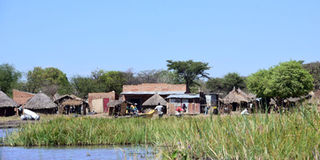On Tisai Island government services are a luxury

Forgotten. A section of Tisai Trading Centre on Tisai Island, Ongino Sub-county, Kumi District. The island enjoys very little basic needs and service delivery from government. PHOTOS BY EDGAR R. BATTE
What you need to know:
Isolated: Tisai, home to some 4,000 people, is a hard-to-reach island located within the wider Kumi District. However, the island has not enjoyed as much, or the least of basic needs and service delivery from government, writes Edgar R. Batte.
The journey to Tisai is as uneasy as the survival of its natives. The wooden canoe, covered in green and yellow colours, is no comforting sight.
It is already heavy, carrying wood, iron sheets, two goats and a motorcycle. The locals, citizen journalists, activists and community monitors, seem all comfortable as we embark, using some help from the ‘captain’ and his turn boy.
To propel the canoe, two men energetically push it to the grass-mouthed shoreline that dithers between a dark and dingy brown colours as the riverbed contents mix and bare out.
The captain, a middle aged and robust man, should be getting tipsy. He holds a local gin polythene bag between his teeth as he navigates the canoe to sail. His hair has recently been darkened to arrest the strands of grey hair.
The 3pm sunshine is having its effect, wetting his forehead with fast running threads of sweat.
He holds the engine propeller in one hand as the other quickly reaches down for some water to wash his head for a cool off.

Transport. People cram into a canoe with their merchandise. This is the main type of transport to Tisai Island.
We are all in, no life jackets, and partially moving to the rhythm of the waves as the engine is momentarily switched off in places with heavy grass and plants.
Until the engine is switched on, I have lost comfort.
I can hardly catch a word of Ateso, but the body language of fellow sailors communicates ease as they laugh, adjusting to comfortable sitting positions and let Mother Nature take its course.
With the recent events that involved loss of lives on Lake Victoria, I guess nothing could ever prepare some minds to cruise so free, with abandon.
To Tisai, we sail, snaking through patches of water plant thickets and beautiful lilies lying on water beds.
There is a plastic bottle here and there.
Tisai, home to some 4,000 people, is an island located within the wider Kumi District but one that has not enjoyed as much, or the least of basic needs and service delivery from government.
It is hard-to-reach area. At first contact, Aggrey Kibet, Cluster coordinator in Pallisa for ActionAid International Uganda, saw an abandoned island, with no schools, no health centres and toilets.
The first sight does not offer much. As the boat nears the docking area, there are people waiting to use its services onto the mainland, with wood which is a cost to tree cover, goats - perhaps for trade ashore, among other items.
Further on, are men seated under a makeshift stand, united by a pot of local brew into which they have placed straw to draw the potent drink. It is hardly 4pm.
A metre away, is a stall selling immature fish. At the school-going hour, many children are seen loitering around the trading centre, some playing.
There is one reasonable school on the island- Tisai Island Primary School, which is privately owned.
The school is grappling with challenges of lack of competent teachers and finance support. As such, some of the teachers are well-wishers. Christine Edith Atim is one of them.
“I have been here for a few months. I have (just) come to help them. I pursued a course to become a plumber, and as I wait for the results from St Kizito Institute in Soroti, I decided to come and teach as a way of helping in Tisai. I teach science and mathematics in Primary Five (P.5) and mathematics in P.3,” Atim, a resident in Ongino Sub-county in Kumi District, explains.
She has not received a salary in months. She says the staff members and pupils depend on good Samaritans and parents who pay, and contribute school dues in form of items such as food and firewood.
Anna Ilemutu was born in Tisai and says one of the challenges locals face on the island is moving long distances to access lake water.

Education. Pupils of Tisai Island Primary School enter their classes. This is the only meaningful school on the island
At the school, pupils are asked to carry water, which is used for cooking and to drink.
“I would say that I am volunteering as a teacher because I don’t know how much my salary is. What comes is what I am thankful for. The last time we were paid, about three months ago, each teacher was given Shs14,000,” Ilemutu, a teacher of English at the primary school, explains.
Call for help
Tisai is part of Ongino Sub-county. With neither a government school nor a functional health centre, locals depend on the mainland for such services.
Moses Moriang, an activist, calls on government to build schools and health centres on the island.
Kibet’s belief is that every citizen deserves access to quality services regardless of their location. “I am driven by the possibilities that organised citizen can derive when they demand for right to service delivery of roads, medicines and development funds, and always inspired to do more when some successes are registered, however small,” the ActionAid’s cluster leader says.
The island could do with some serious regulation of charcoal business to save the islands tree cover and environment.
The open land and canoes ferrying sack loads of charcoal, are proof of continued loss of tree cover.




